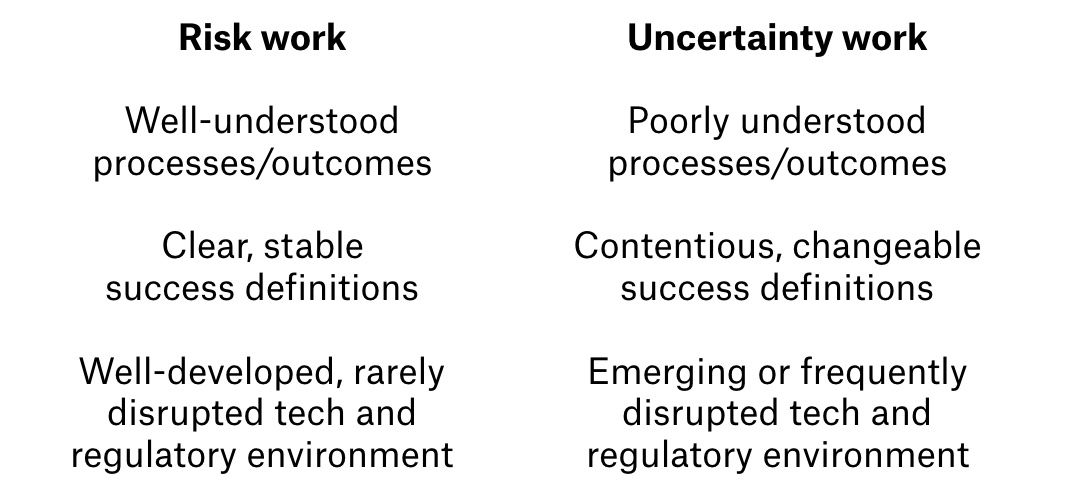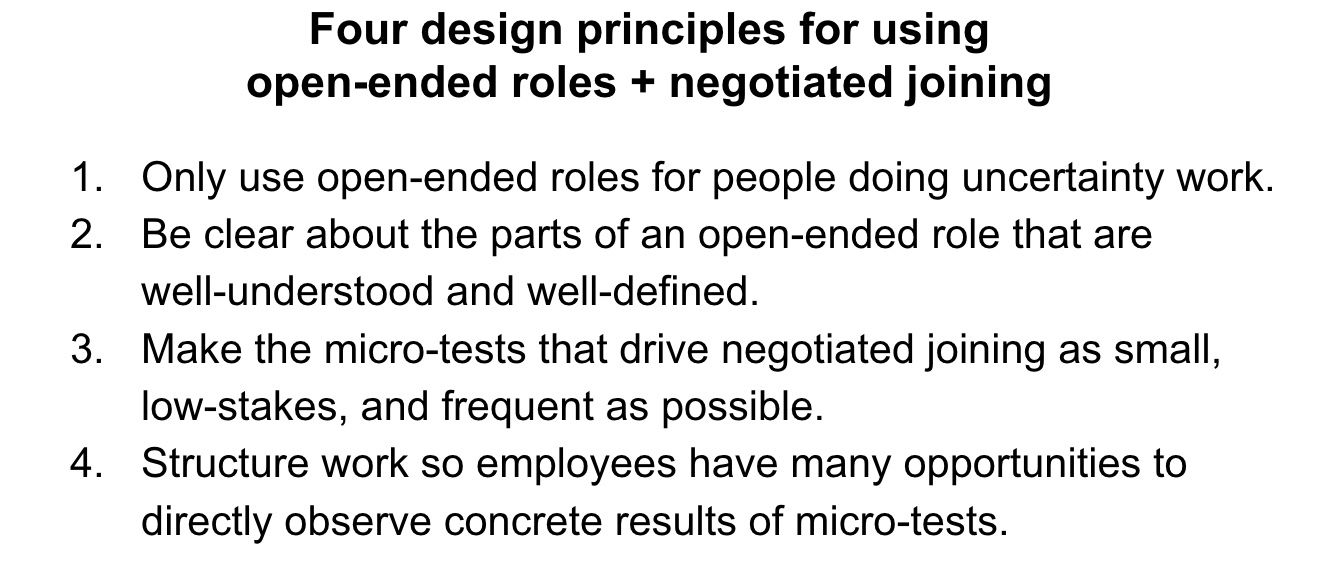Unfrozen from the start
17/10/2023 ☼ uncertainty ☼ organisation design ☼ work
tl;dr: This article describes open-ended roles and negotiated joining, and gives 4 design principles for implementing them in an organisation. With conventional hiring methods, employees expect clear and stable roles, creating organisations that are “frozen” and inflexible from the start. Using open-ended roles with negotiated joining is an unconventional way to build an organisation that starts unfrozen and is good at uncertainty work that isn’t well-understood yet, where rules and operating environments are always changing and being disrupted.
Today’s important work is uncertainty work
Big or small, for-profit or not-for-profit, organisations are now routinely compelled to respond to uncertainty to flourish and even to survive. They have to do uncertainty work, which involves poorly understood processes and outcomes, definitions of success that are under debate and constantly changing, and a still-emerging or frequently disrupted environment.
 Risk work vs uncertainty work
Risk work vs uncertainty work
Uncertainty work is everywhere. An organisation must do uncertainty work to succeed against competitors when new technology disrupts its old industry (e.g., when RNA therapeutics upended drug development) and or even its new industry (e.g., when generative AI’s surging popularity upended FAANG machine learning strategies). This is how innovation and technological change happens. Organisations must also do uncertainty work when they’re disrupted by extreme weather, contagious diseases, and unexpected outbreaks of wars, revolutions, or protests. This is how large-scale social and cultural change happens.
Uncertainty work is not about dealing with mathematically calculable risk. The most important work today is uncertainty work — which is not the same as “risk-management.”
Frozen organisations are often frozen from the start
To be good at uncertainty work, organisations can’t have rigid organisational structures where employees are selected for how well they fit with job requirements that are messaged as being clear, comprehensive and stable. This makes employees expect to perform clearly defined, stable jobs and be on clear, stable career ladders. Relying solely on conventional hiring best practices “freezes” the organisation from the beginning. This makes the people in it unwilling (or even unable) to learn and do new things. A frozen organisation cannot easily innovate or adapt to change or uncertainty.
How to be unfrozen from the start
Organisations doing uncertainty work need to be unfrozen from the start, by adapting the approach used for hiring in two ways:
- Making roles open-ended by explicitly setting expectations during and after hiring that individual roles are flexible and negotiable, and the mix of components in each role (role-components) will probably change over time.
- Enabling role-negotiation instead of selection during initial hiring and ongoing development by building low-stakes, frequent tests and evaluations of role-components into everyday work.
Open-ended roles work with negotiated joining
For organisations, open-endedness in framing an employee’s role means having a mutual understanding with an employee that 80% (say) of their job is clearly defined and 20% left for them to figure out. An open-ended role is one which explicitly leaves a clearly bounded part of the role open to definition or redefinition. Programs like 20% time at Google or 15% time at 3M are one of many possible first steps to open-endedness.
Open-ended roles become effective when they’re paired with role negotiation. How does an employee “figure out”/define the 20% of their role that’s open? By looking around and figuring out what needs to be done (or needs to be done better), actually trying to do that work, and getting feedback on the result from the team they work with. Negotiated joining just means employees looking around for potentially useful role-components to try, testing these new role-components, and getting feedback from the organisation about the results.
The trials I’m talking about in negotiated joining are usually employee-driven and are small/low-stakes enough that they become part of everyday work. These micro-tests shouldn’t feel oppressive and obligatory, as mandatory training programs or large-scale reorganisations often do.
Examples of micro-tests might include:
- A new developer working with a website project team suggests implementing part of the back-end using a new functional programming language. They do a prototype implementation for one module, and let the other developers do some unit testing of the module.
- A new sales team member wants to try a new approach to qualifying leads. They spend a few days developing and calling through to a new leads list and shows the rest of the sales team the conversion numbers.
- A new lawyer on the internal counsel team has deep experience with negotiating enterprise contracts. They offer to do a mark-up of a problematic draft contract currently under negotiation, and circulate it to the rest of the internal counsels for review.
In each of these micro-tests, the employee actually tries out a role-component — “team expert on programming language X,” “team expert on lead qualification method Y”, or “team expert on contract problem Z” — as part of negotiating whether that role-component should become part of their role.
How the negotiation works out depends on whether the rest of the team considers the results of the micro-test successful after seeing it. Is the module is more compact/elegant/reliable? Does the new lead qualification method lead to higher conversion rates? Does the marked-up draft contract address client concerns without incurring unacceptable liabilities? If yes, it’ll make sense for everyone involved for the employee to take on that role-component. If not, people naturally move on.
Over time, the open portion of the employee’s role “fills up” with role-components that they were interested enough in to try out, but only those role-components that have been concretely validated through micro-tests which the rest of the team has evaluated and validated. The negotiation process on open-ended roles naturally balances employees are interested in and good at with what the organisation recognises as valuable and useful.
Incidentally: I’ve used “employee” to describe the person with the open-ended role participating in negotiated joining. But this isn’t limited to only full-time employees. Internship programs, contractor scopes of work, part-time employment, and volunteering engagements can all be designed with open-ended roles and negotiated joining in mind.
Design principles
Open-ended roles and negotiated joining are simple in principle and can be implemented in small ways in almost any organisational context that needs it. Nonetheless there are some design principles for implementing them effectively.
- Only use open-ended roles for uncertainty work. Open-ended roles work best for employees on innovation teams, doing R&D, starting up new business models. They’re really not appropriate for employees whose work is well-understood, easily measured, and not often disrupted.
- Be clear about the part of an open-ended role that is well-understood and clearly defined. If 80% of a role consists of work that is well-understood and has clear success metrics, make both that fraction and what it covers explicit to the employee. Another way to say it is: be explicit and clear about what is open-ended and what isn’t.
- The tests that drive negotiated joining should be as small and low-stakes as possible. The apparent triviality of micro-tests is a feature, not a bug, so resist the temptation to do big, high-stakes testing of big role-components. The point making these tests small is to make them easier to normalise as part of everyday work and reduce the perceived reputational risk of trying something new and untested.
- Structure how work is done so team members have many opportunities to directly observe the concrete results of micro-tests. Practices like group feedback sessions and routine prototype review meetings are opportunities for employees to share micro-tests and for team members to evaluate them. Negotiated joining works more effectively the more frequent these opportunities are.
 Design principles for implementing open-ended roles and negotiated joining in organisations.
Design principles for implementing open-ended roles and negotiated joining in organisations.
Building ever-adapting organisations
With open-ended roles and negotiated joining, employee roles are pieced together from many successful microtests that validate role-components. These organisations naturally have employees whose roles continually shift in small, unpredictable ways which benefit the organisation. These organisations are unfrozen from the beginning, and they’re more likely to respond to uncertain environments by evolving and adapting organically.
Implementing this requires a mindset change but the benefits of doing this are numerous. Employees who are used to the idea of trialing new role-components tend to be better at learning new things (including new ways of doing things). Employees who have a lot of experience with trialing new role-components are more comfortable when their roles evolve to suit new demands on the organisation.
And actually testing and validating role-components (vs just talking about them or putting them on CVs) lets teams avoid a lot of BS because members have seen and thus understand concretely who on the team is good at what.
The biggest challenge for leaders and managers is that they need to be open to the messiness of employees continually trying new things that could benefit the organisation. But though open-ended roles and negotiated joining sound crazily messy, they are in fact counterintuitively simple to put in place. Get in touch if you don’t believe me but want to try it in your organisation.
Part 4 of my book, The Uncertainty Mindset, contains a more detailed description of open-ended roles and negotiated joining, including extended case studies of how the different pieces work both simply and effectively in real-world organisations.